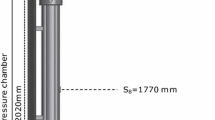Abstract
The interaction of a two-phase flow with a wedge where a stationary shock wave is initially settled is studied in a two-dimensional configuration. Before the introduction of the dispersed phase, the flow around the wedge is a supersonic one phase flow such as an attached stationary shock wave is present. Then, the dispersed phase is introduced upstream the initial position of the stationary shock wave. The purpose of this study is to point out two-phase and droplets break-up effects on the oblique shock wave. The two-dimensional equations are solved by a TVD scheme where fluxes are computed by using Riemann solver for the gas phase equations and also for the dispersed phase equations wich is an original approach due to the authors (Saurel et al. 1994). In addition to drag forces and heat and mass transfers, the process of droplets fragmentation based on the particle oscillation is considered.
Similar content being viewed by others
Abbreviations
- C vs :
-
constant-volume specific heat of dispersed phase [J\kg−1\k−1]
- D :
-
droplet diameter [m]
- C d :
-
drag coefficient
- F dx,y :
-
drag force per unit volume [N·m−3]
- h :
-
convection coefficient around the droplet [W·m−2·k−1]
- L v :
-
specific latent heat vaporisation [J·kg−1]
- \(\dot n_{br} \) :
-
term of droplets production [m−3 st−1]
- N:
-
number of droplet per unit volume [m−3]
- Nu:
-
Nusselt number
- P g :
-
gas pressure [Pa]
- Pr:
-
Prandlt number
- Oh:
-
Ohnesorge number
- Q :
-
convective heat transfer [W·m−3]
- R:
-
universal gas constant [J·kg−1·k−1]
- Re:
-
Reynolds number
- t :
-
time [s]
- T g,s :
-
steam temperature, drop temperature [K]
- U :
-
vector of conservative quantities
- u g,s :
-
x component of the velocity [m·s−1]
- v g,s :
-
y component of the velocity [m·s−1]
- We:
-
Weber number
- Wec:
-
critical number Weber
- W R :
-
solution of the Exact Riemann Problem
- x, y :
-
space coordinates
- α:
-
volume fraction
- δT j :
-
contour of elementT j
- δT j∩δT jk :
-
interface between elementsT j andT jk
- d nj :
-
slopes alongx at time t of conservative variables for elementT j
- δ nj :
-
slopes alongy at timet of conservative variables for elementT j
- Δt :
-
time step [s]
- ⎔τ br :
-
fragmentation time [s]
- Γ:
-
mass transfer [kg·m−3s−1]
- ΓEC:
-
kinetic energy transfer [kg·m−1s−3]
- Γ V:
-
momentum transfer due to mass transfer [kg·m−2·s−2]
- μ:
-
gas viscosity [kg·m−1s−1]
- π:
-
density [kg·m−3]
- ω i :
-
production rate of speciesi
- ω j :
-
center of gravity of elementT j
- λ g :
-
steam thermal conductivity [w·m−1k−1]
- α s :
-
droplet surface-tension [Nm−1]
- inj:
-
relative to the injection
- s:
-
particles
- g:
-
gas
- sx:
-
relative to the particles after break-up
References
Brodkey RS (1967) The phenomena of fluid motions. Addison-Wesley, Reading Mass.
Chang IS (1980) One and Two phase flows. AIAA J18:1455–1461
Elata D, Ben-Dor G, Igra O (1989) The effect of distributions of particle nonuniformities on the flow field behind steady normal shock waves. Int J Heat Fluid Flow10(2)
Fares C (1991) Contribution à l'étude des écoulements diphasiques. Thèse de Docteur de l'Université d'Aix-Marseille
Haas F (1964) Stability of droplets suddently exposed to a high velocity gas steam. AIChE J10(6):920–924
Igra O, Ben Dor G, Aizik F, Gelfand B (1993) Experimental and numerical investigation of shock wave attenuation in dust-gas suspensions. Shock Wave3:49–54
Ishii R, Umeda Y, Yuhi M (1989) Numerical analysis of gas-particle two-phase flows. J Fluid Mech203:475–515
Kolev NI (1993) Fragmentation and coalescence dynamics in multiphase flows. Exp. Thermal Fluid Sci6:211–251
Krier H, Summerfield M (1979) Interior ballistics of guns. Progr in Astro and Aero, AIAA Inc66
Lamb MA (1945) Hydrodynamics. Cambrige Univ. Press. Cambridge U.K.
Lee JHS and Frost DL (1987) Steam explosions-Major problems and current status, 11th ICDERs, Pologne
Littaye G (1943) Sur l'atomisation d'un jet liquide. C R Acad Sct217:340
Martsiano Y, Ben-Dor G, Igra O (1988) Oblique shock waves in dusty gas suspensions. KSME J2(1):35–45
Rowe PN (1961) Drag forces in a hydraulic model of a fluidized model of a fluidized bed. Part II. Trans Instn chem Engrs39:175–186
Sarjeant M (1979) Drop brrakup by gas stream. Third Eur. Conf. on Mixing Univ. York. England 225–267
Saurel R, Larini M, Loraud JC (1992) Ignition and growth of a detonation by a high energy plasma. Shock Waves2:19–29
Saurel R, Daniel E, Loraud JC (1994) Two phase flows: Second order schemes and boundary conditions. AIAA Journal,32(6):1214–1221
Sommerfeld M, Decker S (1993) On the importance of the Basset History term on he particle motion induced by a plane shock wave, Shock Waves3:37–42
Utheza F, Saurel R, Daniel E, Loraud JC (1993) Effects of the injection of droplets on a stationnary shock wave in a nozzle. 19th Symposium of Shock Wave, Marseille
Utheza F, Saurel R, Daniel E, Loraud JC (1994) Effets de l'injection de gouttes sur une onde de choc stationnaire dans une tuyère. Int J Heat Mass Transfer38(14):2595–2610
Van Dongen MEH (1993) Shock waves in condensed matter and heterogeneous media, Shock Waves3:3–10.
Yven MC, Chen LW (1977) Heat transfer measurements of evaporating liquid droplets. Int J of Heat Mass Transfer21:537–542
Author information
Authors and Affiliations
Rights and permissions
About this article
Cite this article
Utheza, F., Saurel, R., Daniel, E. et al. Droplet break-up through an oblique shock wave. Shock Waves 5, 265–273 (1996). https://doi.org/10.1007/BF02425219
Accepted:
Issue Date:
DOI: https://doi.org/10.1007/BF02425219




